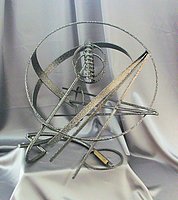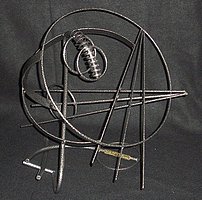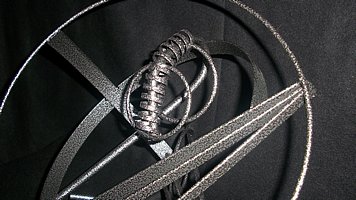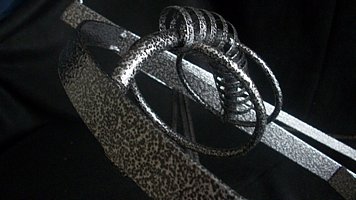Simple Lines and Shapes Fused with Complex Ideas
Four Sculptures By Gilbert McCann: Metal Artist
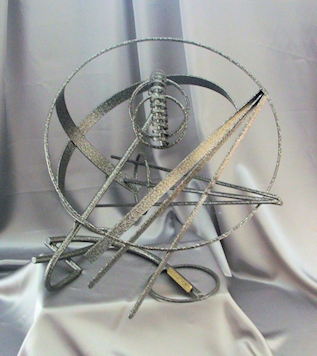
MATHEMATICS
As I began my work on "Mathematics" I thought it to be a discipline dominated by computation and rules. But as the piece began to grow I quickly saw many different aspects of this topic. Shapes appeared (lines and circles). Negative and positive spaces were created. I began to question what the topic mathematics really meant. So I began a study of its definition. Here is what I found.
There are many different definitions of mathematics. All are controversial and there is no consensus. Aristotle defined mathematics as: The science of quantity. This definition was abandoned in the 19th century as new branches of mathematics were developed.
Most reference works define mathematics mainly by summarizing its main topics and methods: The study of the measurement, properties, and relationships of quantities and sets, using numbers and symbols. American Heritage Dictionary, 2000. The science of structure, order, and relation that has evolved from elemental practices of counting, measuring, and describing the shapes of objects. Encyclopedia Britannica.
Bertrand Russell wrote this famous tongue-in-cheek definition: "The subject in which we never know what we are talking about, nor whether what we are saying is true." Other attempts to characterize mathematics have also led to humor. Charles Darwin said, "A mathematician is a blind man in a dark room looking for a black cat which isn't there."
What is mathematics? I have discovered that mathematics is all of the above. Mostly, it's just different. It's not what I expected it to be, turn your back for a moment and it's changed. It's not a fixed body of knowledge and its hidden tendrils pervade every aspect of modern life. What do you see when you view "Mathematics?"
SPECIFICATIONS
Height: 17 inches tall
Width: 20 inches wide
Depth: 14 inches deep
MATERIALS
Powder coated steel
STATUS
Available for purchase

SYMPHONY
My second piece in this series is a look at the complex topic of music. This was a natural topic to work on as the connection to mathematics is very important. There are two main meanings of music. the first meaning is: vocal or instrumental sounds (or both) combined in such a way as to produce beauty of form, harmony, and expression of emotion. the second meaning is: the written or printed signs representing vocal or instrumental sound. It is the second meaning that has such a close tie to mathematics.
Music is presented in many different forms from classical symphonies to heavy metal rock. As I worked on this piece I saw a way to meld all the musics together. I saw a stringed instrument in the straight lines. It could be a violin, harp, guitar, bass or many others. I saw the beauty of form and expression of emotions in the swirling lines and spheres they wrap around. I wondered how I could bring all of these many types of music and instruments together to bring meaning to my piece. Then I came upon this definition of symphony: something regarded, typically favorably, as a composition of different elements. I hope you will enjoy sharing with me in my "SYMPHONY."
SPECIFICATIONS
Height: 23 inches
Width: 13.5 inches
Depth: 14 inches
MATERIALS
Steel round stock powder coated; chrome sphere
STATUS
Available for purchase

ROBOTIC INTERVENTION
You may have noticed that the first two pieces are related to educational disciplines. My third piece also is related to education through the discipline of science. Science is definitely a series of complex ideas and topics, one of which is robotics.
I was asked by Dr Douglas Iddings to create a second piece of art for his office related to the curing of cancer. The first piece I created for the doctor was "VICTORY." You can see this sculpture on one of the pages of this portfolio. It also is on display in the lobby of the Genesys Hurley Cancer Institute, on Kensington Ave, Flint, MI.
Dr Iddings is a surgical oncologist. In talking about this piece, and what he would like it to contain, he spent time with me explaining some of the newer techniques and science being used in the curing of this terrible disease. He shared with me some of the surgical robotic tools he uses in his work. It was from this discussion that "ROBOTIC INTERVENTION" was born.
In looking at the pictures of the sculpture can you see these parts: the patient's body, the robotic instruments, a black sphere, steel flames, and a lighted crystal spire? This is what each component stands for. The black sphere is the darkness of your world when you are first told you have this horrible disease. I see the surgeon applying his skills to the body, using robotic technology, to eradicate the cancer. I see the flames of determination as the patient and the surgeon work together. And finally, I see the light of hope as the patient heals.
SPECIFICATIONS
Height: 17.5 inches
Width: 15 inches
Depth: 10 inches
MATERIALS
Strap steel, hand tapered steel rod, hollow steel sphere housing LED lighting, sheet metal, crystal spire, surgical robotic instruments.
STATUS
Commissioned by oncologist Dr. Douglas Iddings. This sculpture can be seen at the Genesys Hurley Cancer Institute on Kensington Ave, Flint, MI.

SIMPLY NEWTON
As I was planning for my exhibit, Heavy Metal, at Kettering University in Flint, MI I was asked by the gallery's curator if I did Kinetic Art. She said some of the staff enjoyed that form of art. I told her I would be happy to create a kinetic piece for my show. I was telling my wife about the request and as a teacher before she retired, she asked why didn't I create a sculpture that could be used as a teaching tool for young students. That was the beginning of "Simply Newton."
I wanted my piece to help young students understand motion. And I wanted it to be pleasing to the eye but more than an outdoor wind sculpture. We researched and decided that Newton's First Law of Motion - An object at rest remains at rest, or if in motion, remains in motion at a constant velocity unless acted on by a net external force - would be a great topic to portray. I set about creating a pendulum to help students understand this law. Once the pendulum was completed, we were fascinated by how long it would continue its motion. We realized that while using this piece to teach about motion we would also talk about many other scientific ideas, such as: inertia, gravity and friction. I remembered lessons taught to me years before and realized that kinetics is about motion and the energy associated with it. So I decided to use the energy created to complete the task of ringing a bell. I now have another area to introduce students to - the law of conservation of energy - Energy cannot be created or destroyed, but only changed from one form into another or transferred from one object to another. I wonder what else I can do with "Simply Newton."
SPECIFICATIONS
Height: 74 inches
Width: 17 inches
Depth: 16 inches
MATERIALS
Steel, Brass, Powder Coating
STATUS
Available for purchase
Click on any image below to see a larger overlay view of these sculptures.
